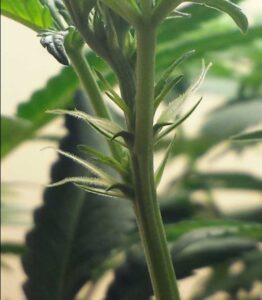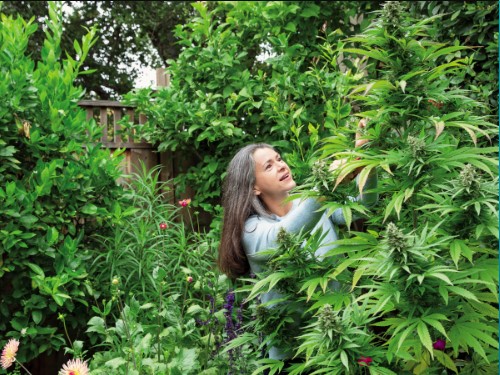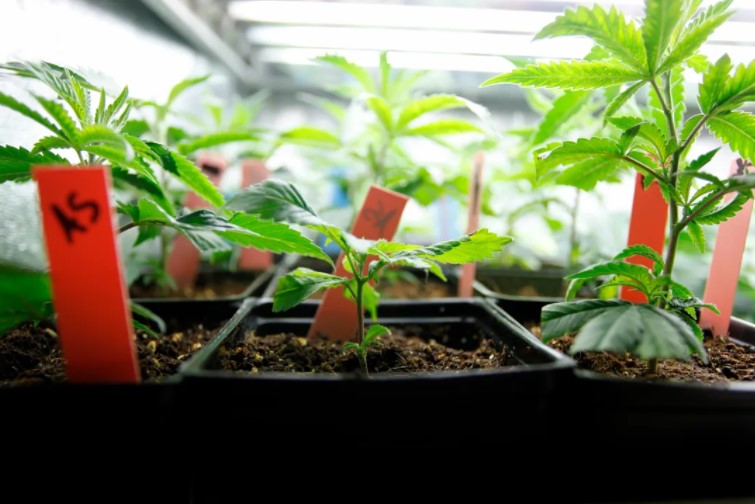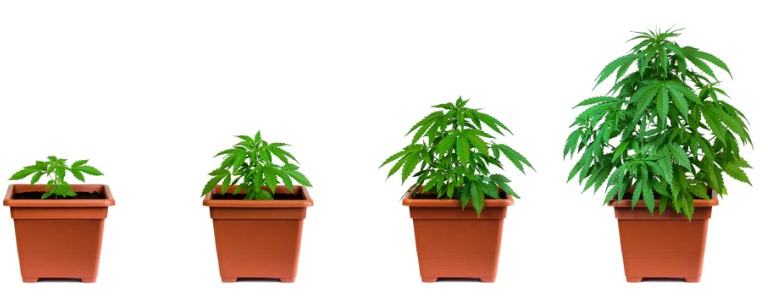Embark on the artful journey of cultivating cannabis, where the key to success lies in knowing precisely when to “flip to flower.” This comprehensive guide unravels the intricacies, guiding you through factors shaping this crucial transition. Whether under the open sky or within the controlled confines of an indoor space, we explore the strategic mastery of light cycles, empowering you to unlock your cannabis plant’s full potential. Join us on a journey through growth stages, revealing the nuanced decisions that lead to a thriving harvest. Elevate your cultivation expertise and ensure success in every flip to flower.
Importance of Timing in Cannabis Cultivation
Understanding the nuances of timing is the backbone of successful cannabis cultivation, particularly when transitioning from the vegetative stage to the flowering phase. The timing of this pivotal shift can significantly impact the overall health, size, and yield of your cannabis plants. Let’s explore why timing is of the essence for cannabis growers:
a. Yield Optimization:
- Flipping to the flowering stage too early may result in underwhelming yields. Premature initiation of the flowering phase can limit the plant’s growth potential, leading to smaller and less potent buds.
b. Mitigating Overgrowth and Burn:
- On the flip side, delaying the transition to the flowering stage can lead to overgrowth issues or burnt bud sites. Understanding the optimal timing helps strike a balance, ensuring that your plants don’t outgrow their designated space while avoiding damage from prolonged exposure to intense light.
c. Strain-Specific Considerations:
- Different cannabis strains exhibit unique growth profiles. What suits a sativa strain might not be applicable to an indica variety. Recognizing the distinct characteristics of your chosen strain is crucial in determining the right time to transition, preventing unnecessary complications during the flowering phase.
d. Environmental Adaptations:
- For outdoor growers, timing is influenced by natural light cycles. While Mother Nature takes care of triggering the flowering phase, indoor cultivators have the flexibility to manipulate lighting schedules. Adapting to environmental conditions ensures a seamless transition for both types of growers.
e. Plant Age and Growth Stage:
- The age of your cannabis plants and the duration they spend in the vegetative stage play integral roles in the timing decision. Considering factors such as germination time, seedling phase, and vegetative stage duration helps fine-tune the transition for optimal results.
f. Seed vs. Clone Dynamics:
- Whether you’re growing from cannabis seeds or clones introduces additional variables. Each method comes with its own set of considerations, impacting the overall growth trajectory of your plants. Timing the transition becomes a tailored process based on the chosen cultivation approach.
In essence, mastering the art of timing is more than a mere technicality—it’s a holistic understanding of your cannabis plants’ unique needs and characteristics. By carefully considering the factors outlined above, cultivators can navigate the delicate balance between vegetative and flowering stages, setting the stage for a successful and bountiful harvest.
Outdoor Growing vs. Indoor Growing
Cannabis cultivation is a versatile endeavor, with growers adapting their methods to the environment they cultivate in. Whether under the open sky or within the controlled confines of an indoor space, the approach to transitioning from the vegetative stage to flowering varies significantly. Let’s explore the considerations for both outdoor and indoor growers:
a. Natural Lighting Schedules for Outdoor Growers:
- Outdoor growers benefit from the natural rhythm of sunlight, dictated by the changing seasons. Mother Nature orchestrates the transition to the flowering stage through variations in day length. Understanding regional climatic conditions and the duration of daylight helps outdoor cultivators synchronize their cultivation with the environment.
- Seasonal Adaptations: Recognizing the seasonal shifts is pivotal. Outdoor growers leverage the longer days of spring and early summer for vigorous vegetative growth, knowing that the decreasing daylight hours in late summer and fall will trigger the flowering phase naturally.
- Less Light Control: While outdoor growers have less control over the duration of light exposure, they can harness the advantages of sunlight intensity and spectrum, contributing to robust plant development.
b. Strategies for Indoor Growers to Control Flowering Times:
- Indoor cultivators, on the other hand, have the flexibility to dictate the lighting schedule for their cannabis plants. Controlling the transition from vegetative to flowering stage becomes a strategic element in maximizing yields.
- Vegetative Light Cycle: During the vegetative stage, indoor growers typically provide their plants with 18-24 hours of continuous light, simulating the longer days of spring and early summer.
- Flowering Light Cycle: To induce the flowering stage, a switch to a 12-12 lighting schedule is common—12 hours of light followed by 12 hours of uninterrupted darkness. However, the method of transitioning can vary.
- Cold Turkey Method: Some growers opt for an immediate switch to 12-12, mimicking a sudden shift in natural light conditions.
- Gradual Reduction: Others prefer a gradual reduction over 2-3 weeks, mimicking the changing daylight hours as the seasons progress.
- Dark Period Induction: A few growers introduce 1-2 days of total darkness before initiating the 12-12 cycle, providing an extra push for the plants to enter the flowering phase.
- Adaptation to Growing Methods: The chosen growing methods, such as Sea of Green (SoG) or Screen of Green (ScrOG), influence when the transition occurs. Each method has its specific requirements for plant size and structure before initiating flowering.
In summary, whether basking in the natural sunlight or under the glow of artificial lights, outdoor and indoor growers employ distinct strategies in timing the transition to the flowering stage, adapting to the unique challenges and advantages of their chosen cultivation environment.
Factors Influencing the Transition
A successful transition from the vegetative stage to the flowering phase in cannabis cultivation hinges on a nuanced understanding of several key factors. These factors, ranging from the genetic makeup of the chosen strain to the cultivation method employed, collectively shape the optimal timing for initiating the flowering stage. Let’s delve into the intricacies of these influential factors:
a. Strain Selection and Unique Growing Profiles:
- Strain-Specific Characteristics: Each cannabis strain boasts its own set of characteristics, influencing everything from plant height to flowering time. Recognizing whether you’re dealing with an indica, sativa, or a hybrid of the two is fundamental. Indicas tend to be shorter, while sativas can reach greater heights. Understanding the unique growing profile of your chosen strain is paramount in determining the ideal transition time.
- Guidance from Reputable Seed Banks: Reputable seed banks often provide essential information, including approximate flowering times and expected plant height. This guidance aids cultivators in aligning their expectations and planning for the transition accordingly.
b. Plant Age and Vegetative Stage Duration:
- Age-Related Considerations: The age of your cannabis plants plays a crucial role in the transition decision. It involves accounting for the time spent in the germination, seedling, and vegetative stages. Balancing the desire for robust growth with avoiding excessive vegetative development is key.
- Variable Vegetative Stage Times: The duration of the vegetative stage varies across strains, ranging from 3 to 16 weeks. Understanding the specific requirements of your chosen strain enables you to fine-tune the timing of the transition, ensuring optimal plant development.
c. Seed vs. Clone Cultivation:
- Growing from Seeds: Cultivating cannabis from seeds introduces variability in plant characteristics. While this natural diversity can lead to unique and desirable traits, it also means that the transition timing may need to be more adaptable. Seed-grown plants may exhibit subtle differences in growth patterns, requiring a keen eye to determine the ideal moment for flowering.
- Cannabis Clones (Weed Plant Clipping): Cloning offers a more predictable growth trajectory, as the new plants share genetic material with their parent. This predictability allows for a more precise estimation of when to transition to the flowering stage.
d. Choice of Growing Medium:
- Impact of Growing Medium: Whether you’re cultivating in soil, hydroponics, or another medium, the choice profoundly influences plant development. Different mediums offer varying nutrient availability and moisture retention, affecting the overall growth rate and health of the plants. Understanding how your chosen medium interacts with your specific strain aids in determining the optimal timing for transitioning to flowering.
- Medium-Specific Considerations: Hydroponic systems may necessitate slightly different transition timings compared to soil-based cultivation. Tailoring the transition approach to the specific characteristics of your chosen growing medium ensures a harmonious integration of environmental factors.
In conclusion, the transition from the vegetative stage to flowering in cannabis cultivation is a delicate dance influenced by a myriad of factors. Strain selection, plant age, cultivation method, and growing medium are all integral components that, when understood and considered collectively, empower cultivators to make informed decisions for a successful transition and ultimately, a bountiful harvest.
Determining When to Switch to Flowering
The decision of when to transition cannabis plants from the vegetative stage to the flowering phase is a critical juncture that varies between commercial-scale operations and everyday growers. Both perspectives bring unique considerations to the table, emphasizing the need for a nuanced approach in determining the optimal time to switch to flowering.
a. Commercial Growers’ Perspective:
- Precision and Efficiency: Commercial-scale operations often follow a meticulous schedule honed through experience and standardized practices. In these settings, growers typically wait to flip their crops to flower after about 6-8 weeks in the vegetative stage. This approach is driven by the need for efficiency, predictable timelines, and the optimization of large-scale yields.
- Systematic Approaches: Commercial growers benefit from established systems that streamline the cultivation process. Standardizing the transition period allows for synchronized harvesting and resource allocation, contributing to a smoother workflow.
b. Everyday Growers’ Considerations:
- Variable Factors: Everyday growers, whether tending to a few plants for personal use or engaging in a small-scale operation, navigate a landscape with more variability. The decision to switch to flowering involves a careful consideration of several factors, including the strain’s characteristics, growing environment, and the grower’s specific goals.
- Personalization and Adaptability: Unlike commercial operations, everyday growers have the flexibility to personalize their cultivation approach. Considering the unique combination of factors such as strain selection, plant health, and environmental conditions allows for a more adaptable strategy.
c. Importance of Considering Various Factors:
- Strain-Specific Requirements: Different cannabis strains exhibit distinct growth patterns and flowering timelines. What works for one strain may not be suitable for another. Understanding the specific requirements of the chosen strain is paramount for both commercial and everyday growers.
- Environmental Adaptations: Whether cultivating indoors or outdoors, the surrounding environment plays a crucial role. Factors such as light intensity, temperature, and humidity contribute to the overall health and growth of cannabis plants. Evaluating these environmental elements aids in making informed decisions about when to transition.
- Cultivation Goals: The goals of the cultivator, be it maximizing yield, personal consumption, or experimenting with different strains, influence the timing of the transition. Everyday growers often have more flexibility to align their cultivation practices with personal preferences and objectives.
In essence, the decision of when to switch from the vegetative stage to flowering transcends a one-size-fits-all approach. Commercial growers prioritize efficiency and systematic practices, while everyday growers leverage adaptability and a personalized touch. Regardless of the scale, both perspectives underscore the importance of considering a multitude of factors to ensure a successful transition and ultimately, a rewarding harvest.
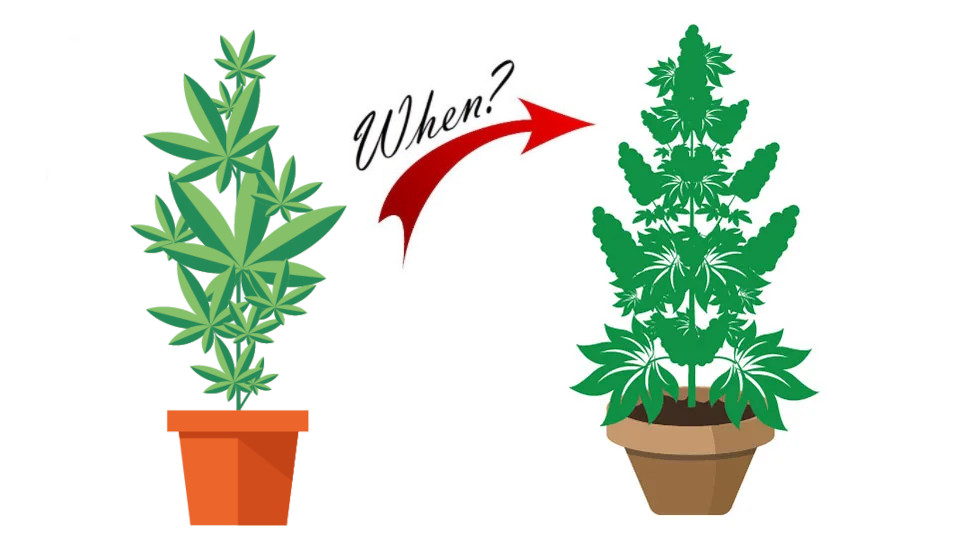
Answering the Question: When Can I Flip to Flower?
The pivotal decision to transition cannabis plants from the vegetative stage to flowering is an intricate process that blends art and science, demanding careful consideration of specific growth indicators. In answering the question of when to flip to flower, cultivators focus on reaching the plant’s maximum potential, drawing concrete guidelines from factors such as the number of sets of leaves and plant height.
a. Reaching the Plant’s Maximum Potential:
- Optimal Leaf Development: Before initiating the transition, cultivators look for the optimal development of leaves, typically aiming for a plant with at least five to seven sets of well-formed leaves. This leaf maturity signifies a robust capacity for photosynthesis, ensuring the energy reserves needed for the upcoming flowering phase.
- Height Considerations: The decision to flip to flower is closely tied to the plant’s height, with an average range of 12 to 24 inches being a common guideline. This height range is often influenced by strain characteristics and the chosen cultivation method.
b. The Relationship Between Healthy Plant Growth and Height:
- Strain-Specific Guidelines: Different strains come with distinct growth characteristics, influencing the ideal height for transitioning. Indica-dominant strains, for instance, may be ready for flowering when they reach approximately 12 to 18 inches, while sativa-dominant varieties might require a height of 18 to 24 inches. Referring to strain-specific guidelines provided by seed banks assists in setting height expectations.
- Growing Method Impacts: The chosen growing method, whether utilizing the Sea of Green (SoG) or Screen of Green (ScrOG) techniques, further refines the decision-making process. For SoG, growers often initiate flowering once plants reach a height of 12 inches, while ScrOG may necessitate waiting until plants comfortably fill the designated screen space.
c. Personalizing when to Flip to Flower:
- Cultivator’s Goals: The cultivator’s goals play a significant role in determining when to flip to flower. Depending on the desired outcome—be it maximizing yield, managing space, or experimenting with specific strains—personalization of the decision is key.
- Observation and Experience: Experienced cultivators often factor in the number of sets of leaves and height alongside a keen observation of overall plant health. A well-established understanding of individual strain characteristics, coupled with practical experience, empowers growers to make nuanced decisions based on the unique needs of their plants.
Conclusion
In conclusion, answering the question of when to flip to flower involves tangible criteria such as the number of sets of leaves and plant height. By combining these concrete guidelines with a personalized understanding of cultivation goals, cultivators can confidently navigate the transition, setting the stage for a successful flowering phase and eventual harvest.
Concrete guidelines, such as the number of sets of leaves and plant height, serve as invaluable tools for growers seeking precision in their decisions. As a rule of thumb, a thriving cannabis plant should boast five to seven sets of well-formed leaves before transitioning, with height considerations falling within a range of 12 to 24 inches, influenced by strain characteristics and growing methods.
The art of cannabis cultivation extends beyond the technicalities; it’s an intimate relationship between the cultivator and the plant, an alliance built on observation, experience, and a deep understanding of individual strains. Whether you’re a commercial grower aiming for efficiency or an everyday cultivator weaving a personalized touch into your approach, the journey to a bountiful harvest is marked by adaptability and consideration of the unique factors influencing your cultivation space.
In essence, the answer to the question “When can I flip to flower?” lies in the synthesis of knowledge, experience, and a profound connection with your cannabis plants. As you navigate the growth phases, from germination to flowering, may your cultivation journey be both rewarding and infused with the satisfaction of nurturing healthy, thriving plants. Happy growing!

